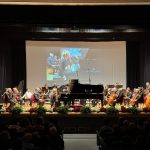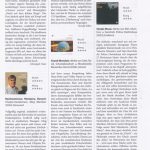A splendid first instalment of a three-volume cycle.
Maurice RAVEL (1875-1937)
Complete Solo Piano Music Volume 1
Sérénade grotesque(c.1893) [3:23]
Menuet antique(1895) [7:42]
La Parade(1896) [14:14]
Pavane pour une infante défunte(1899) [7:00]
Jeux d’eau(1901) [5:57]
Menuet in C-sharp minor (1904) [1:11]
Miroirs(1904-1905) [30:23]
Fugue in F major (1900) [4:59]
Oleg Marshev (piano)
rec. July 2021, Cultural Institute, Milan, Italy
DANACORD DACOCD903[75:51]A new survey of Maurice Ravel’s piano music is always welcome. It is an even more significant event when the plan is to record the composer’s all extant works for the instrument: an important first. And with Danacord’s superstar Oleg Marshev at the piano it is just perfect.
It gets better. This programme is largely chronological, and that allows an informed appreciation of Ravel’s development as a composer. Also, a few pieces here rarely make it into surveys of his piano music:La Parade, the Menuet in C-sharp minor and the Fugue in F major.
Le Paradewas devised for Antonine Meunier of the Paris Opera to accompany her interpretive dancing. It includes two marches, two waltzes and a mazurka. The piece, composed under the pseudonym “Jacques Dream”, was only published in 2008. I enjoyed it, even if it is no masterwork. It is interesting simply because it is by Ravel, and it is an essential part of any complete recording of his music.
Ravel wrote Menuet in C-sharp minor on the back of a composition exercise by his pupil Maurice Delage (1879-1961). It may have been created for the student’s benefit or for Ravel’s own amusement. Whatever the genesis, this gorgeous miniature deserves to be better known. Although it lasts just over a minute, is full of beauty and charm. It is not a fragment, but a well-constructed piece, complete with a climax and an ideal equilibrium of harmony and melody.
The Fugue in F major is a rarity indeed. Along with several others, possibly now lost, it was composed as part of Ravel’s “serial and unsuccessful attempts” to win the Prix de Rome between 1900 and 1905. The holograph is written on four staves, reflecting Bach’s practice inArt of the Fugue. Oleg Marshev has arranged this for two hands at the keyboard. This wonderful fugue has no whiff of the pedantic about it, even if it is not typically Ravelian in style.
Ravel’s earliest surviving piano piece begins the disc.Sérénade grotesquecombines hints of the “fantastic irony” of the composer’s future style – such asScarbofromGaspard de la nuit– and nods to the past, with echoes of Emmanuel Chabrier’sBourrée fantasque.
Menuet antiqueforeshadows Ravel’s true genius; once again Chabrier was the inspiration. In this beautifully organized pastiche, the composer plays with the minuet form, but there are some wonderful contemporary harmonic touches.
Little need be said about the ever popularPavane pour une infante défunte, save that this is not an elegy for an unnamed member of Spanish royalty. Ravel once said that he “simply liked the sound of these words and I put them there, c’est tout”. On the other hand, there is a heart-breaking wistfulness about the grave and stately progress of the dance.
One might imagine that the ultra-impressionisticJeux d’eauwas influenced by Claude Debussy, but it was the other way round. Ravel, in turn, was likely to have been inspired by Franz Liszt’sLes Jeux d’eaux à la Villa d’Estefrom theTroisième annéeofAnnées de pèlerinage(1877). He wrote: “InJeux d’eaucan be found the origins of all the pianistic innovations that people notice in my works. The piece was inspired by the sound of water, of fountains, waterfalls and streams. It is built on the two motives of a sonata form movement, without, however, conforming to the classical scheme of tonality.” Despite this loosely classical formal scheme, the overall impression is of cascading arpeggios. Marshev gives a delightfully imaginative performance of this ultimate in “water music”. It was dedicated to Ravel’s teacher Gabriel Fauré.
Miroirsmarks the composer’s “establishment of [his]…firmness of style and pianism”; he refines his pianistic technique to perfection. It is a major contribution to the piano literature. The opening movement,Noctuelles, conjures the fluttering of moths at night-time.Oiseaux tristesmuses on birds, which the composer described as “lost in the torpor of a very dark forest, during the hottest hours of summertime”. The best known movement,Une barque sur l’océan, gives an impression of a very blue Mediterranean, with just a hint of a breeze stirring up wavelets. Spain is visited next withAlborada del gracioso– the Dawn Song of the Clown. Here Ravel introduces the panoply of the Iberian Peninsula: “twanging guitars and clacking castanets, all conspiring in typical rhythms” complete with double glissandi and repeated notes. It is the most technically challenging of the set. The final movement,La vallée des cloches, evokes bells heard in the distance. It is a study of deeply felt piano sonorities. The composer once said that the closing chords echoed “the sound of the big bell in the Basilica of Montmartre in Paris”. Each movement was dedicated to a fellow member of Les Apaches, a group of avant-garde musicians, writers and artists.
Oleg Marshev’s sensitive but commanding performance captures the magic from the first to the last page. At all times, he judges and balances the mood and atmosphere well. I have not heard his earlier recording of Ravel’s two piano concertos (DACOCD 672), but I can imagine that it is superb.
As always with Danacord, the recording is impressive. Peter Quantrill’s excellent liner notes give a good account of each piece and put the music in the context of Ravel’s life and times. I was disappointed with the bland CD cover: one wishes for something more dynamic for such an exciting project!
I look forward to the remaining two volumes of this cycle. The powers that be at Danacord say that all the recordings are already “in the can”.
John France


